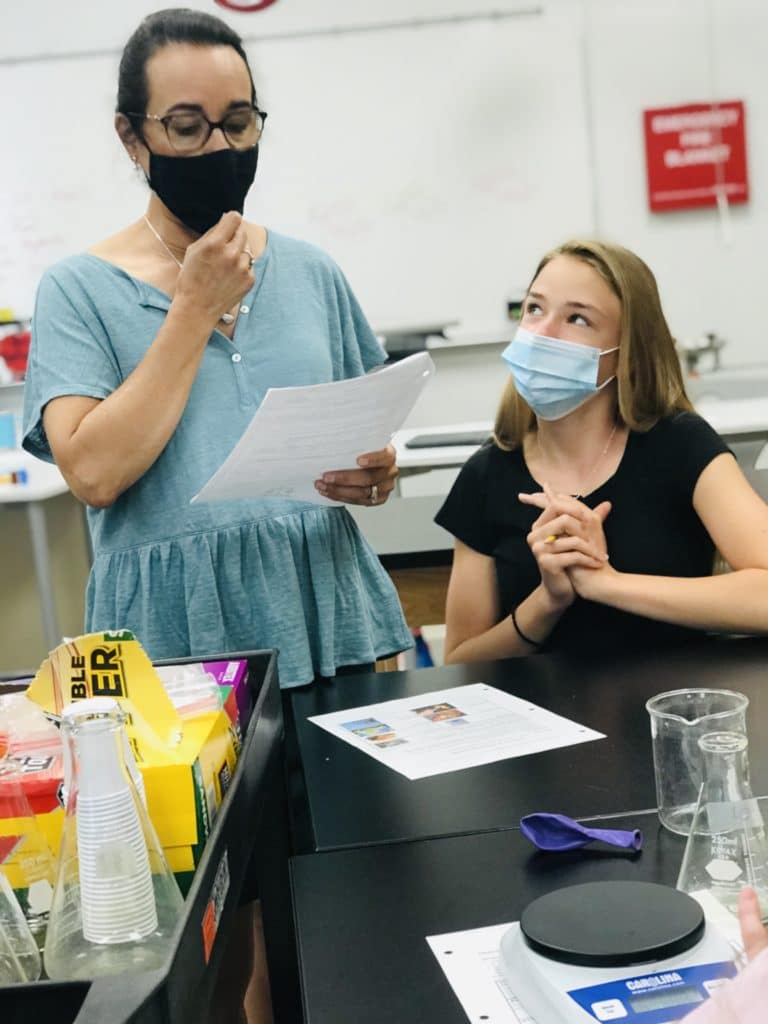Program Director Theresa Powers recently sat down for a conversation with Middle School Science Teacher Julie Hartung about her experience at MSSA. The conversation has been edited for print.
Many people become teachers straight out of their university programs, but sometimes people become educators later in life, which is what you have done. What was your first career?
My first career was working in clinical laboratory settings including North Central Baptist Hospital here in Stone Oak. I was the lead for the microbiology section, and I did blood-banking, chemistry, urinalysis, and other clinical lab tests that people rely on when they go to the hospital or get a blood test.
What brought you to teaching?
We had students from local high schools like Churchill and Reagan who were enrolled in health professions classes cycle through the departments at the hospital, and I would show them different areas and teach them about testing. I was also responsible for professional development and training new staff in my department. I enjoyed teaching so much that I felt the need to follow my passion for sharing science with others.
Where are you from?
I was born and raised in Corpus Christi. I went to UT Austin and have a degree in Microbiology as well as a degree in Medical Technology. I have a Masters in Educational Leadership from UT Arlington.
Where else have you taught?
I started out as a substitute and then became a para-professional and worked with special needs non-verbal students at Bill Brown Elementary School in Comal ISD. I went on to teach Middle School Science at Spring Branch Middle School in Comal ISD and then Vale Middle School in Northside ISD.
What do our MSSA Middle School students study in your Science classes?
Seventh graders study life science, with a focus on understanding ecosystems and organisms, and then we move to organic chemistry and the elements of life from the cellular level moving out to body systems. Eighth graders are immersed in the study of matter and energy, and they learn about force, motion, and Newton’s Laws – all conceptual physics. Students learn about atoms and period table trends and how elements combine to form compounds through chemical reactions.
Can you talk about your approach to teaching?
My approach to teaching is inquiry-based. I like to put students in situations where they experience something and use equipment to see what happens. We talk about what they notice, and they ask questions. Then I follow up with another experiment or experience to reinforce learning objectives and we spiral back to the first questions that they had. They are able to make connections and understand both what’s happened and why.
I know that hands-on labs are important for your students. What are some of your favorite labs?
I really like when we study the stars. We use spectrophotometers to see where light is absorbed as elements show up in lines or bands. Each element has its own fingerprint, and every star has hydrogen or helium. It’s really a continuation of the Story of the Universe from the Montessori elementary years.
You have been earning an Upper Elementary Montessori credential this year. What made you want to work on that?
I wanted to better understand how to support students as they cross the bridge from Upper Elementary to Middle School and beyond. I’ve loved learning about the Montessori materials because they really allow for a connection between concrete and abstract thinking.
We call our Middle School program and hybrid program. Which parts are more Montessori and which parts are more conventional?
We follow a schedule where we switch classes and have separate subject areas. Students have homework and grades for assessments in Middle School – those are the conventional parts. But even those classes are longer blocks of time than conventional schools, which is more like the uninterrupted Montessori work period. What’s also more Montessori is how we hold our Morning Meeting each day, and students take care of their areas and are responsible for the spaces. We also allow time to explore and expand out with ideas through the Passion Project, which students do in both seventh and eighth grades. We are small and work with their pace, which allows everyone to express who they are, and we all get to know each other as a community –that’s a Montessori piece.
What are you most proud of regarding the Middle School?
The Middle School teachers really work well together as a team, which clearly supports the growth and development of students as they exit from the Middle School.
What do you like to do in your spare time?
I like to spend time with my family. We fish together, exercise, and go on vacations. On our most recent vacation we went to New York City; we went to the Metropolitan Museum of Art, and we saw Wicked on Broadway.
Julie Hartung is the Middle School Level Lead. She is earning her Upper Elementary Montessori Credential through the North American Montessori Center (NAMC). She is looking forward to using the new outdoor classroom patio that our Facilities team has built adjacent to the Middle School building.

